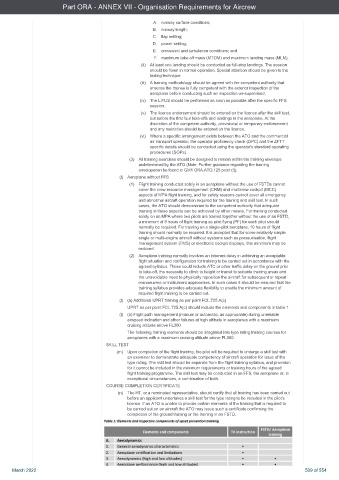Page 509 - UK AirCrew Regulations (Consolidated) March 2022
P. 509
Part ORA - ANNEX VII - Organisation Requirements for Aircrew
A . runway surface conditions;
B. runway length;
C. flap setting;
D. power setting;
E. crosswind and turbulence conditions; and
F . maximum take-off mass (MTOM) and maximum landing mass (MLM).
(ii) At least one landing should be conducted as full-stop landings. The session
should be flown in normal operation. Special attention should be given to the
taxiing technique.
(iii) A training methodology should be agreed with the competent authority that
ensures the trainee is fully competent with the exterior inspection of the
aeroplane before conducting such an inspection un-supervised;
(iv) The LIFUS should be performed as soon as possible after the specific FFS
session;
(v) The licence endorsement should be entered on the licence after the skill test,
but before the first four take-offs and landings in the aeroplane. At the
discretion of the competent authority, provisional or temporary endorsement
and any restriction should be entered on the licence.
(vi) Where a specific arrangement exists between the ATO and the commercial
air transport operator, the operator proficiency check (OPC) and the ZFTT
specific details should be conducted using the operator's standard operating
procedures (SOPs).
(3) All training exercises should be designed to remain within the training envelope
asdetermined by the ATO (Note: Further guidance regarding the training
envelopecan be found in GM1 ORA.ATO.125 point (f)).
(l) Aeroplane without FFS
(1) Flight training conducted solely in an aeroplane without the use of FSTDs cannot
cover the crew resource management (CRM) and multicrew cockpit (MCC)
aspects of MPA flight training, and for safety reasons cannot cover all emergency
and abnormal aircraft operation required for the training and skill test. In such
cases, the ATO should demonstrate to the competent authority that adequate
training in these aspects can be achieved by other means. For training conducted
solely on an MPA where two pilots are trained together without the use of an FSTD,
a minimum of 8 hours of flight training as pilot flying (PF) for each pilot should
normally be required. For training on a single-pilot aeroplane, 10 hours of flight
training should normally be required. It is accepted that for some relatively simple
single or multi-engine aircraft without systems such as pressurisation, flight
management system (FMS) or electronic cockpit displays, this minimum may be
reduced.
(2) Aeroplane training normally involves an inherent delay in achieving an acceptable
flight situation and configuration for training to be carried out in accordance with the
agreed syllabus. These could include ATC or other traffic delay on the ground prior
to take-off, the necessity to climb to height or transit to suitable training areas and
the unavoidable need to physically reposition the aircraft for subsequent or repeat
manoeuvres or instrument approaches. In such cases it should be ensured that the
training syllabus provides adequate flexibility to enable the minimum amount of
required flight training to be carried out.
(l) (a) Additional UPRT training as per point FCL.725.A(c)
UPRT as per point FCL.725.A(c) should include the elements and components in table 1.
(l) (b) Flight path management (manual or automatic, as appropriate) during unreliable
airspeed indication and other failures at high altitude in aeroplanes with a maximum
cruising altitude above FL300
The following training elements should be integrated into type rating training courses for
aeroplanes with a maximum cruising altitude above FL300:
SKILL TEST
(m) Upon completion of the flight training, the pilot will be required to undergo a skill test with
an examiner to demonstrate adequate competency of aircraft operation for issue of the
type rating. The skill test should be separate from the flight training syllabus, and provision
for it cannot be included in the minimum requirements or training hours of the agreed
flight training programme. The skill test may be conducted in an FFS, the aeroplane or, in
exceptional circumstances, a combination of both.
COURSE COMPLETION CERTIFICATE
(n) The HT, or a nominated representative, should certify that all training has been carried out
before an applicant undertakes a skill test for the type rating to be included in the pilot’s
licence. If an ATO is unable to provide certain elements of the training that is required to
be carried out on an aircraft the ATO may issue such a certificate confirming the
completion of the ground training or the training in an FSTD.
March 2022 509 of 554

